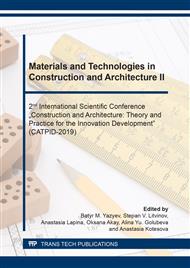[1]
O.V. Kovalchenko, N.I. Alfimova, To the question of the application of volcanic products in building materials, Bulletin of BSTU named after V.G. Shukhov. 6 (2017) 24–28. (In Russian).
Google Scholar
[2]
A.S. Pogromsky, T.V. Anikanova, The effect of long-term storage of electric steel smelting slags in dumps on their properties, Construction Materials and Products. 1 (1) (2018) 32–39. (In Russian).
DOI: 10.34031/2618-7183-2018-1-1-32-39
Google Scholar
[3]
T.A. Hezhev, A.V. Zhurtov, A.S. Tsipinov, S.V. Klyuev, Fire resistant fibre reinforced vermiculite concrete with volcanic application, Magazine of Civil Engineering, 4 (2018) 181–194.
Google Scholar
[4]
E.V. Fomina., V.V. Strokova, N.I. Kozhukhova, A.E. Fomin, Effect of mechano activation on size parameter of aluminosilicate rocks, Indian Journal of Science and Technology, 9(22) (2016) 95545.
DOI: 10.17485/ijst/2016/v9i22/95545
Google Scholar
[5]
N.I. Kozhukhova, E.V. Fomina, I.V. Zhernovsky, V.V. Strokova, R.V. Chizhov, The utilization efficiency of natural alumosilicates in composite binders, Applied Mechanics and Materials, 670-671 (2014) 182-186.
DOI: 10.4028/www.scientific.net/amm.670-671.182
Google Scholar
[6]
R.S. Fediuk, Y.G. Yevdokimova, A.K. Smoliakov, N.Y. Stoyushko, V.S. Lesovik, Use of geonics scientific positions for designing of building composites for protective (fortification) structures, IOP Conf. Series: Materials Science and Engineering 221(2017) 012011.
DOI: 10.1088/1757-899x/221/1/012011
Google Scholar
[7]
Sh. M. Rakhimbaev, N.M. Tolyipina, Justification for choosing of binder type for aggressive organic media taking into account the theory of physical and mechanical processes, Bulletin of BSTU named after V.G. Shukhov, 9 (2016) 159–163. (In Russian).
Google Scholar
[8]
D.S. Korzhinsky, Physical and chemical principles of analysis of paragenesis for minerals. Moscow: An SSSR. 1957. 184. (In Russian).
Google Scholar
[9]
D. Harlov, H. Austrheim, Metasomatism and the chemical transformation of rock: Rock-mineral-fluid interaction in terrestrial and extraterrestrial environments. Springer. (2013) 806.
DOI: 10.1007/978-3-642-28394-9_1
Google Scholar
[10]
V.V. Reverdatto, Development of understanding of Korzhinsky D.S. about local balance of mineral under metamorphism, Geology and geophysics. 51 (3) (2010) 329‒337. (In Russian).
Google Scholar
[11]
E.A. Tolstov, D.E. Tolstov, Physical and chemical geotechnologies. Opening of deposits of uranum and aurum in Kyizyilkumsky region. Monography. Moscow: Geoinformcenter. 2002. 277. (In Russian).
Google Scholar
[12]
T. Ekström, Leaching of Concrete. Lund Institute of Technology. 2001. 229.
Google Scholar
[13]
W. David, Law Effect of Leaching on pH of Surrounding Water, Magazine of Concrete Research 110(3) 2013 291–296.
Google Scholar
[14]
V. Foldyna, J. Foldyna, D. Klichova, Effects of water jets on CNTS/concrete composite, MM Science Journal.01 (2018) 2229-2233.
DOI: 10.17973/mmsj.2018_03_201775
Google Scholar
[15]
Yu.M. Bazhenov, Concrete technology. Moscow: ACB. 2011. 528. (In Russian).
Google Scholar
[16]
M.A. Frolova, A.S. Tutyigin, A.M. Aizenshtadt, V.S. Lesovik et al, Assessment criterion of surface energy properties, Nanosystems: Physics, chemistry, mathematics. 2 (4) (2011) 120–125.
Google Scholar
[17]
I. Flores-Vivian, R. GK Pradoto, M. Moini, M. Kozhukhova et al, The effect of SiO2 nanoparticles derived from hydrothermal solutions on the performance of portland cement based materials, Frontiers of Structural and Civil Engineering. 11(4) (2017) 436-445.
DOI: 10.1007/s11709-017-0438-2
Google Scholar
[18]
P.V. Trunov, N.I. Alfimova, V.S. Lesovik, V.V. Potapov, E.E. Shadsky, Towards utilization of volcanic raw materials from Kamchatka as a mineral additive, Bulletin of BSTU named after V.G. Shukhov. 4 (2014) 84–89. (In Russian).
Google Scholar
[19]
B.V. Gusev, A.S. Faivusovich, Experimental studies of leaching processes in concrete when filtration, Building and reconstruction. 2 (58) (2015) 96–104. (In Russian).
Google Scholar
[20]
D.S. Korzhinsky, Dependence of metamorphism on deepness of volcanic formations, Materials of laboratory volcanology AN SSSR. 19 (1961) 5–11.
Google Scholar
[21]
I.G. Luginina, I.N. Afonina, Effect of Portland cement composition on efflorescence, Cement and its application. 1 (2007) 90–91. (In Russian).
Google Scholar
[22]
A.N. Rosental, G.V. Lubarskaya, Concrete corrosion when interaction between alkalis and SiO2 in aggregate, Concrete and reinforced concrete, 1 (2012) 50–60.
Google Scholar


